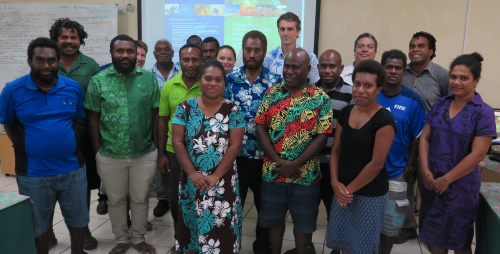
Vanuatu is a stronghold of biodiversity in the Pacific islands region and there are many sites throughout the country that have high conservation value owing to their role as key habitats for vulnerable and endemic species. Vanuatu ratified the Convention on Biological Diversity in 1993 and the identification, designation and management of protected areas for biodiversity conservation and livelihoods is a key priority for the government of Vanuatu. In 2018, a Protected Areas Advisory Committee (PAAC) was established and formalised to ensure that Vanuatu’s protected area targets and broader protected area priorities are met through a coordinated and inclusive manner.
A national protected area workshop engaging the PAAC members including the Vanuatu Fisheries Department, Vanuatu Department of Forests, Vanuatu Environmental Science Society (VESS), Vanuatu Environmental Advocacy Network (VEAN), Wan Smolbag theatre, Live and Learn Vanuatu and others was held earlier this month with the goal of ensuring accurate and reliable information for decision making and to inform policy formulation for future programs and projects development and monitoring of progress towards the achievement of protected area targets for Vanuatu.
The workshop was organised by the Vanuatu Department of Environmental Protection and Conservation (DEPC) with support of the Secretariat of the Pacific Regional Environment Programme (SPREP) through the EU-ACP Biodiversity and Protected Areas Management (BIOPAMA) programme.
Participants shared progress of their current protected area-related initiatives, challenges faced and lessons learnt – staffing, funding and conflicting data held by government and NGOs were highlighted. An update on the progress of implementation of Vanuatu’s National Roadmap for Aichi Target 11 was provided and challenges faced with its implementation highlighted.

“The workshop is a timely initiative as it helps us to better coordinate ourselves and collectively track our progress towards achieving the Aichi target 11,” said Ms Rolenas Baereleo, Senior Conservation Officer,Vanuatu DEPC.
“Most of the conservation area information currently resides with either communities, NGOs or government agencies. Thus, improving coordination and dialogue among these key players is vital for success of current and future work and initiatives involving our protected areas,” she added
The Pacific Islands Protected Area Portal (PIPAP), a ‘one stop online portal’ for all Pacific protected areas information, was promoted during the workshop, with basic training delivered on the key features and use of the portal. Participants learned how to access and view their country data, conduct searches for information resources and locate technical guidance on different aspects of protected area management available through the portal.
“The discussions and exchanges between stakeholders during the workshop were very positive. It was particularly encouraging to see active discussion of national progress to achieve Aichi target 11 on protected areas, with specific focus on tracking Vanuatu’s roadmap to implement this global target,” said Mr Vainuupo Jungblut, Protected Areas Officer of SPREP.
“The lack of data repositories at the national level for protected area data was again highlighted as an issue amongst stakeholders as well as capacity constraints. The gathering today heralds a renewed willingness and urgency to better coordinate, share knowledge and proposed solutions to address protected areas management issues.”
The Vanuatu Protected Area Advisory Committee (PAAC), established in 2018, was a priority action facilitated by SPREP through the BIOPAMA programme, an initiative of the African, Caribbean and Pacific (ACP) Group of States financed by the European Union’s 11th European Development Fund. The technical workshop on protected areas for Vanuatu, held March 12 2019, was a partnership between the Vanuatu Department of Environmental Protection and Conservation (DEPC) and SPREP also supported through BIOPAMA.
Similar technical consultations and training also took place in 2018 in the Cook Islands and Tuvalu, and most recently in Palau and Niue. Further missions and trainings are planned to take place over the coming months.
BIOPAMA is jointly implemented by the International Union for Conservation of Nature (IUCN) and the Joint Research Centre of the European Commission (EC-JRC). In the Pacific region, BIOPAMA is implemented by IUCN’s Oceania Regional Office (IUCN ORO) in partnership with the Secretariat of the Pacific Regional Environment Programme (SPREP). The partnership between IUCN ORO and SPREP has seen the enhancement of the Pacific Islands Protected Area Portal (PIPAP), the ‘one-stop shop’ for all information on Protected Areas maintained by SPREP with partners and Members.
For more information please contact Mr. Vainuupo Jungblut on [email protected].